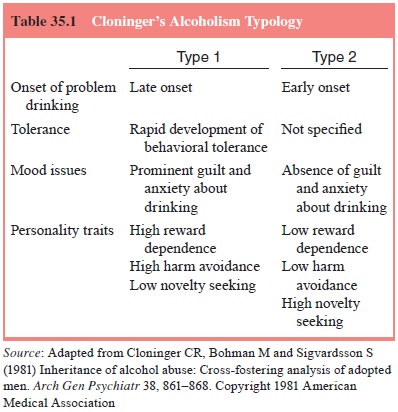Chapter: Essentials of Psychiatry: Substance Abuse: Alcohol Use Disorders
Etiology and Pathophysiology - Alcohol Use Disorders
Etiology and Pathophysiology
Alcoholism is a complex, multifaceted disorder
which has long been recognized to run in families. There is substantial
evidence from twin research and adoption studies that a major genetic component
is operative in the development of alcoholism. Nonetheless, the dis-order is
etiologically complex, with a variety of other vulnerability factors. It has
been estimated that there is a sevenfold risk of al-coholism in first-degree
relatives of alcohol-dependent individuals, with male relatives of male
alcohol-dependent individuals having the greatest risk for the disorder.
However, the majority of alcohol-dependent individuals do not have a
first-degree relative who is al-cohol dependent. This underscores the fact that
the risk for alcohol dependence is also determined by environmental factors,
which may interact in complex ways with genetics. In addition to study-ing
genetic contributions to alcoholism, another approach to under-standing the
etiology of alcoholism is to identify distinct subtypes of alcoholics. The best
known of these typologies is the Type 1/Type 2 distinction developed by
Cloninger and colleagues (1981) from studies of adopted sons of Swedish
alcoholics (see Table 35.1).
Type 1 alcoholics are characterized by the late
onset of prob-lem drinking, rapid development of behavioral tolerance to
alco-hol, prominent guilt and anxiety related to drinking, and infrequent
fighting and arrests when drinking. Cloninger also termed this

subtype “milieu-limited”, which emphasizes the
etiologic role of environmental factors. In contrast, Type 2 alcoholics are
character-ized by early onset of an inability to abstain from alcohol, frequent
fighting and arrests when drinking, and the absence of guilt and fear
concerning drinking. Cloninger postulated that transmission of alcoholism in
Type 2 alcoholics was from fathers to sons, hence term the male-limited alcoholism. Differences in the two subtypes are
thought to result from differences in three basic personality (i.e.,
temperament) traits, each of which has a unique neurochemi-cal and genetic
substrate. Type 1 alcoholics are characterized by high reward dependence, high
harm avoidance and low novelty seeking. In contrast, Type 2 alcoholics are
characterized by high novelty seeking, low harm avoidance and low reward
dependence.
Cloninger also hypothesized that specific
neurotransmitter systems underlie personality structure. Specifically, dopamine
is hypothesized to modulate novelty seeking, which is character-ized by
frequent exploratory behavior and intensely pleasurable responses to novel
stimuli. Serotonin is hypothesized to modulate harm avoidance, which is a
tendency to respond intensely to aver-sive stimuli and their
conditionedsignals.Finally,norepinephrineis hypothesized to modulate reward
dependence or the resistance to extinction of previously rewarded behavior.
Although Clonin-ger’s typology has generated substantial research, studies have
failed to provide empirical support for this tridimensional per-sonality scheme
and other aspects of the classification (Glenn and Nixon, 1991; Schuckit et al., 1990; Sannibale and Hall, 1998;
Vaillant, 1994).
Implicit in the subtyping theories that have been
developed to explain different clinical varieties of alcoholism is the notion
that there are a variety of plausible etiological factors in addition to or
mediated by genetic predisposition. Three such factors are pharmacological
vulnerability, affective dysregulation and per-sonality disorder. The evidence
for pharmacological vulnerabil-ity as an etiological factor is based on studies
showing reduced sensitivity to the effects of alcohol in adult children of
alcoholics (Schuckit and Smith, 1996; Pollock, 1992). Other evidence comes from
research on the effects of the alcohol metabolizing enzymes aldehyde
dehyrogenase and alcohol dehydrogenase pymor-phisms in individuals of Asian
ancestry in which aversive reac-tions to the effects of alcohol are associated
with reduced risk of alcohol dependence (Thomasson et al., 1993). A second etiologi-cal factor is affect
dysregulation, which proposes that alcoholism is caused by repeated use of
alcohol to “self-medicate” negative affective states such as anxiety and
depression. This theory is supported by research indicating strong associations
between al-cohol problems, mood disorders and life stress (Schuckit, 1985). The
third etiological factor that has received considerable re-search support is
deviance proneness or behavioral undercontrol, as indicated by hyperactivity,
distractibility, sensation seeking, impulsivity, difficult temperament and
conduct disorder. These conditions are hypothesized to contribute to school
failure and association with deviant peers, which then provide a context for
heavy drinking and drug use (Sher and Trull, 1994).
In summary, despite considerable progress in the
identifi-cation of risk factors for alcoholism, the interactions among
ge-netic, familial, psychological, interpersonal and environmental influences
remain so complex that there is little consensus about etiology at this time.
Related Topics